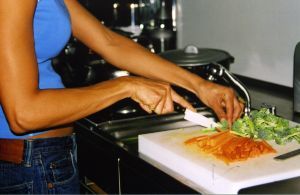A super easy way to prepare vegetables is to roast them. Roasted vegetables have an intense flavor that cannot be matched by any other method of cooking. Most garden variety vegetables can be roasted with ease. Roasting is essentially cooking foods at high temperatures which removes the water faster than any other method, and the result is an intense, rich flavor that lasts. Here are some tips to help you get the best flavor from your vegetables when roasting, what vegetables you should choose and those to avoid, and information on preparation.
The Basics of Roasting
Unlike baking, roasting is generally done at high temperatures. Depending on the type of vegetable you are roasting you will need to adjust the temperature accordingly. Most roasting is done between the temperatures of 400-475 degrees Fahrenheit. The intense heat and dryness of the oven during roasting causes vegetables to loose moisture (water) very quickly causing them to shrink. Because the vegetables shrink so quickly the trapped flavor is very rich, kind of like marinating but instead of adding flavor, you are keeping it. The browning that occurs during roasting also adds a distinct taste for each individual vegetable. Also unlike baking, roasting requires very little fat.
Vegetables That Can Be Roasted
Almost any garden variety vegetable can be roasted. Of course some vegetables are just not suited to roasting like leafy greens and those with very high water content. The best vegetables for roasting are those considered roots such as carrots, potatoes, beets, and radishes. Listed here are some other suggestions:
Red/Green/Yellow Bell Peppers
Tomatoes
Corn
Parnsnips
Green Beans/String Beans
Chilis/Jalapenos
Mushrooms
Sprouts
Asparagus
Squash
Zucchini
Onions
Vegetables to Avoid Roasting
Because of their high water content and fraility most leafy greens are not suitable for roasting. If you try to roast the following vegetables you will find they wilt, stick, burn, and dry out too much. Avoid trying to roast these vegetables:
Collard Greens
Mustard Greens
Lettuce
Water Chestnuts
Baby Corn
Kale
Spinach
Preparing Vegetables for Roasting
Depending on the vegetagble there may be a few different ways to prepare them. For most garden variety types cutting them into cubes or chunks is fine. To make sure your vegetables cook and brown evenly it is important to make sure the vegetables are uniform in size and shape. For vegetables like peppers and onions it is usually better if you slice them into strips, but not too thin because they will dry out and burn. Most vegetables should be prepared in just about the same way as for sauteeing or stir fry.
After cutting up your vegetables you can rinse them with clean cold water but it is not neccessary. When using potatoes for roasting you will get better results if you rinse away some of the extra starch so they can brown and crisp on the outside. If you choose to rinse your vegetables make sure they are dry before moving on to the next step. Pour the vegetables into a large mixing bowl or plastic zipper bag and toss with 1-2 tablespoons of oil. During this time you should also add in your preferred seasonings and salt to taste. Too much oil and the vegetables will turn out more like a fried food; too little oil and the vegetables will dry out and be crunchy or crispy. You want some crisp to the outside but just enough oil to allow the vegetables to brown without burning.
Temperature and Cook Times
Because the temperature and cook times can vary greatly for different vegetables it is best to roast them separately. But, many vegetables can be cooked together as long as they are similar, such as potatoes and carrots, onions and peppers, or tomatoes and mushrooms. There are no specific rules as to what temperature you have to roast foods at, but in general the higher the water content and the higher the density of the vegetable, the higher the temperature. Vegetables like potatoes, squash, zucchini, jalapenos, and green beans can be roasted at temperatures of 450 degrees Fahrenheit and higher. Onions, peppers, mushrooms, tomatoes, and corn should be cooked at temperatures less than 450 degrees Fahrenheit down to about 400. Temperatures lower than 400 will not cook the vegetables thoroughly nor will they brown accordingly.
After greasing and seasoning your vegetables lay them out on a flat baking sheet in a single layer. Most vegetables will roast in about 15-20 minutes. Vegetables like onions and peppers can be roasted in as little as 7-10 minutes. During roasting shake the pan or turn over the vegetables once or twice to keep them from sticking, or burning.When it comes to roasting vegetables experience really is the only way to learn. You may want to try out different temperatures and herbs to figure out exactly what you want to get out of roasting. With some practice roasting vegetables will become first hand knowledge and you will find it really is easy. Roasting vegetables is a great way to bring out their natural earthy flavor without having to do much at all.
